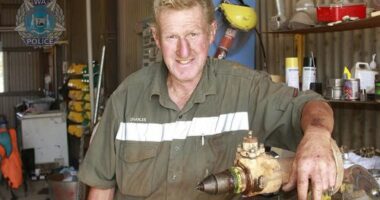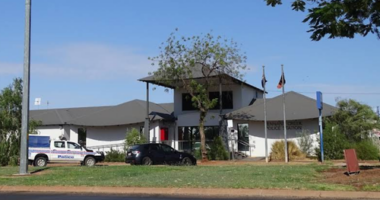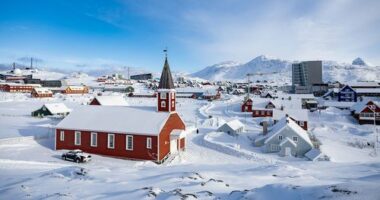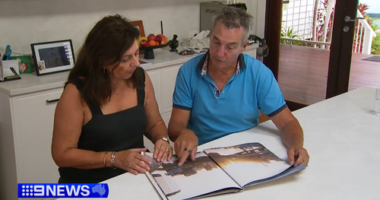Share this @internewscast.com
Soon, hand-harvested sea cucumbers will be dried, processed and shipped to lucrative markets in South-East Asia. It’s a far more streamlined system than the one that existed in the early 1700s, when sea cucumbers (trepang) were first traded by First Nations groups in the Top End. Each year, thousands of fishermen from Makassar, a port city in modern-day Indonesia, would sail the trade winds south to Arnhem Land to exchange goods for the delicacy, which is Australia’s earliest export.

Sea cucumbers belong to the same animal group as starfish and sea urchins, called echinoderms. Source: Supplied / Tidal Moon
“From what the records show, they used to swap sea cucumbers for iron for their spears,” Wear says.
I thought it was incredible that there was a trade before colonisation.
“Right now, you’re either rich or you’re on Centrelink, there’s nothing in between.”

Michael Wear demonstrates the sun-drying room at Tidal Moon’s processing facility in Shark Bay, where the company dries sea cucumbers using natural light. Source: SBS News / Otis Filley
Wear established Tidal Moon in 2017 and has since trained 12 young divers, employing two full-time staff members, Alex Dodd and Shyem Nicette. As the young faces of the First Nations-led business, they work under the mentorship of Tidal Moon’s head of offshore operations, Sean McNeair, to harvest sea cucumbers in unpredictable conditions. They’re affectionately known as Shark Bay’s ‘saltwater cowboys’.
But the ripple effects of the business reach beyond the community. The saltwater cowboys are drawing on traditional knowledge to restore damaged seagrass, the beating heart of life in Shark Bay.
The threat of ‘carbon bombs’
It’s a landscape as harsh as it is fragile, and there is no clearer example than the world’s largest seagrass meadows, which sweep 4,000 square km of Shark Bay’s banks like an indigo carpet across the seafloor.

Shark Bay’s extensive seagrass meadows are among the largest and most diverse seagrass ecosystems in the world. Source: SBS News / Otis Filley
These underwater forests are a playground for whales, sharks, dugongs, dolphins, turtles, crabs, and tourists, who flock in four-wheel drives to the World Heritage-listed area. But, like most of the planet’s seagrass meadows, they are disappearing as the climate simmers.
“One of the key things we’re trying to do is keep the carbon capture in the seafloor. Without seagrass restoration, carbon bombs go off. There are about 40 million tonnes of CO2 at risk [of being released] in Shark Bay. That’s nine LNG [liquefied natural gas] trains,” Wear says.

Shark Bay has been listed as a UNESCO World Heritage site since 1991, which includes its coastal waters, nature reserves and lagoons. Source: SBS News / Otis Filley
The ‘building block’ for life in the bay
“We have a responsibility from a cultural perspective that we need to look after the area because it sustains us. It’s who we are, it’s our identity,” says Darren ‘Capes’ Capewell, a Nhanda and Malgana man who runs cultural tours in Shark Bay.
Wirriya jalyanu means grass from the ocean. It’s the building block for all life in the bay.
“They don’t say that we’ve lost seagrass. They’ll refer to a sand patch, and the sand patch is actually growing. Inadvertently, they’re saying we’ve lost seagrass,” Capewell explains.

Darren ‘Capes’ Capewell says conserving Shark Bay is integral to the continuation of First Nations cultures and identity in the area. Source: SBS News / Otis Filley
Fifteen years have passed since Shark Bay’s last marine heatwave, but the ocean has not recovered. Some patches are empty of turtles, or have a glut of catfish, says Wear. While deep underwater, his divers have catalogued over 4,000 hours of footage — a ‘living library’ of marine observations.
In August 2024, Tidal Moon was given a ‘ground-breaking’ 13-year translocation permit from Western Australia’s government to scale up seagrass restoration. This, plus a BHP Blue Carbon grant worth $2.2 million, will help towards their ambitious goal of replanting 1,000 square kilometres of seagrass in Shark Bay.
Traditional Owners, including Tidal Moon’s divers, have a “careful” and “circular” approach to marine conservation, she explains.

Tidal Moon’s approach to sea cucumber harvesting draws on 30,000 years of traditional knowledge. Source: SBS News / Otis Filley
Breaking into the sea cucumber market
“[Sea cucumbers] are the earthworms of the ocean. The function of sea cucumbers is overturning the soil and redistributing nutrients, but seagrasses, in turn, protect sea cucumbers, giving them a home to work within,” she says.

Marine scientist Jennifer Verduin is among a team of researchers working closely with Tidal Moon divers to restore seagrass species in Shark Bay. Source: SBS News / Otis Filley
Harvesting sea cucumbers relies on reading the intricate rhythms of the tides and the moon — a process that inspired the name Tidal Moon.
“The first day you dive, it becomes an obsession,” he says.
For me, it’s like going to the moon – underwater, it’s a whole different planet. It’s quiet and you can hear yourself breathe, you’re in amongst animals and wildlife you’re not usually part of.
Poor weather conditions have halted the team from harvesting sea cucumbers this week, but on a typical day, the divers take a two-hour voyage to Steep Point, Australia’s most western tip. There, they search the seafloor, collecting sea cucumbers by hand. Once their net bags are filled with around 300-500 leathery sea cucumbers, they return to shore.

Sea cucumbers have small, tubular feet that they use for both movement and feeding. Source: Supplied / Tidal Moon
These sea cucumbers — mostly of the deep-water redfish variety — are dried and sent to a Singaporean partner for export throughout South-East Asia. Known as bêche de mer, the culinary delicacy is enjoyed in Chinese soups and eaten raw or fermented in Japan.
‘Equality of access’
Sea cucumber is not a staple of Australian cuisine, although a 2024 AgriFutures report projected prices to “surge” as demand increases. The global market value of sea cucumber is around $6.8 billion for 200,000 tonnes, but Australia is yet to capitalise on this industry, with its annual wild catches accounting for less than 400 tonnes.

Sea cucumbers are ‘benthic’ creatures, meaning they dwell on the ocean floor, and are found in both shallow and deep sea environments. Source: Supplied / Tidal Moon
Tidal Moon hopes to get ahead of the curve and eventually expand into aquaculture — farming sea cucumbers in a controlled environment. Wear’s eyes are on markets in Australia, the US and Europe, where the invertebrate is a burgeoning superfood. Due to sea cucumbers’ high collagen, amino acid and vitamin content, they can be milled into capsules for the lucrative biomedical market.
Tidal Moon initially struggled to enter the Western Australian sea cucumber fishery in 2017, as the wholesalers Tasmanian Seafoods held a monopoly on sea cucumber licences in the state. Although Australia’s fishing industry is worth a sizable $3.6 billion, Indigenous people have traditionally been excluded from the sector due to heavy regulations and high costs.

Tidal Moon’s research partnership aims to explore the medicinal and nutritional potential of sea cucumbers, as well as their marine conservation applications. Source: SBS News / Otis Filley
Wear says he wants to create a self-sufficient Indigenous business, one that doesn’t rely on a trickle of grants or government funding.
“We’re this small little Indigenous business, on its own back, trying to change the world,” Wear says.
Preserving Gathaagudu
“I grew up without a father, so I know what it’s like. I hope we can keep many more in the family.”

Michael Wear (far left) hopes to expand Tidal Moon’s operations. Source: SBS News / Otis Filley
Alex Dodd is a Malgana and Amangu man and the company’s lead diver.
“Now I can continue to preserve it for the next generation.”

Alex Dodd shows a shell collected during a dive in the waters of Shark Bay, where he recently purchased a home with his partner. Source: SBS News / Otis Filley
This story was supported by the Pulitzer Center.












